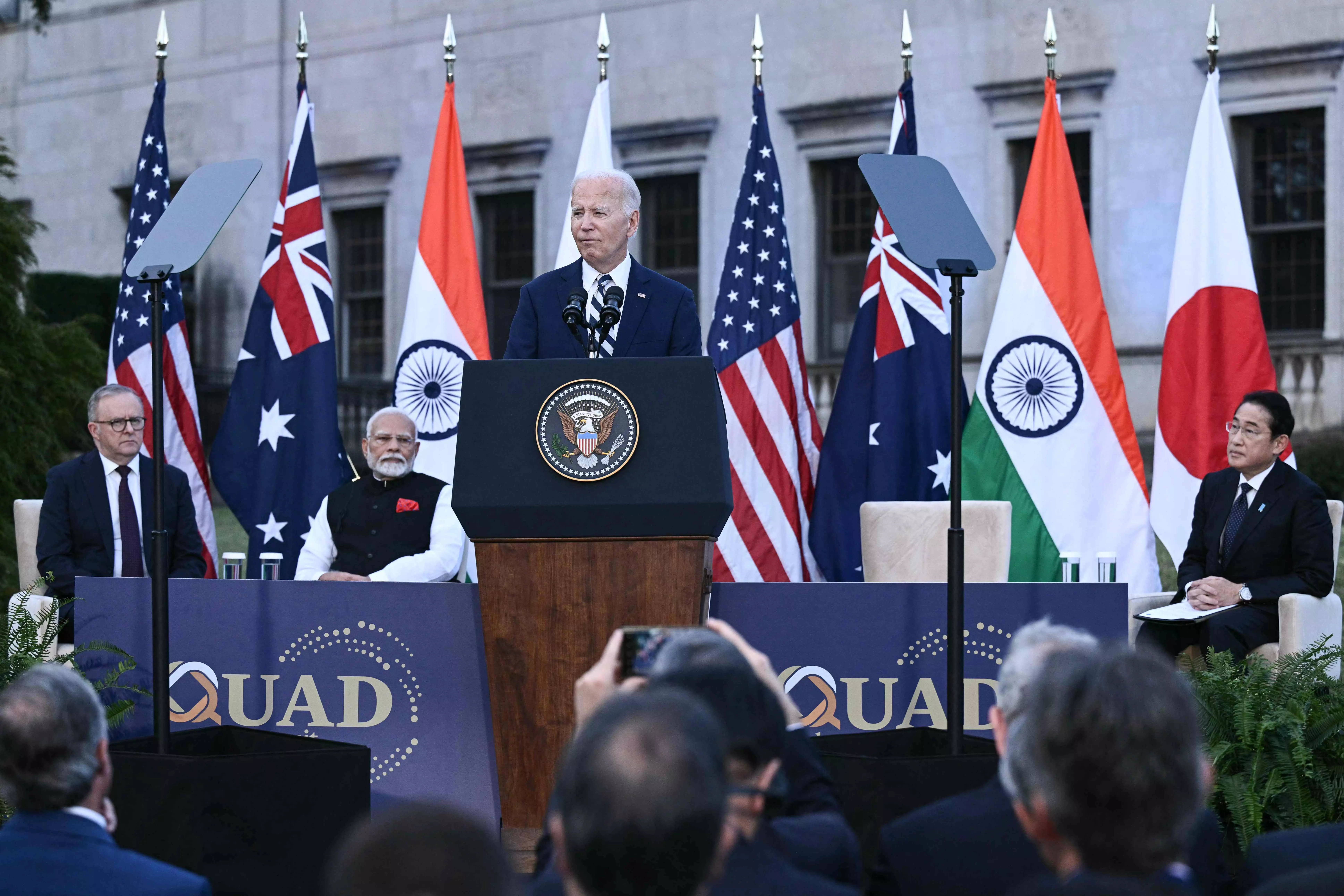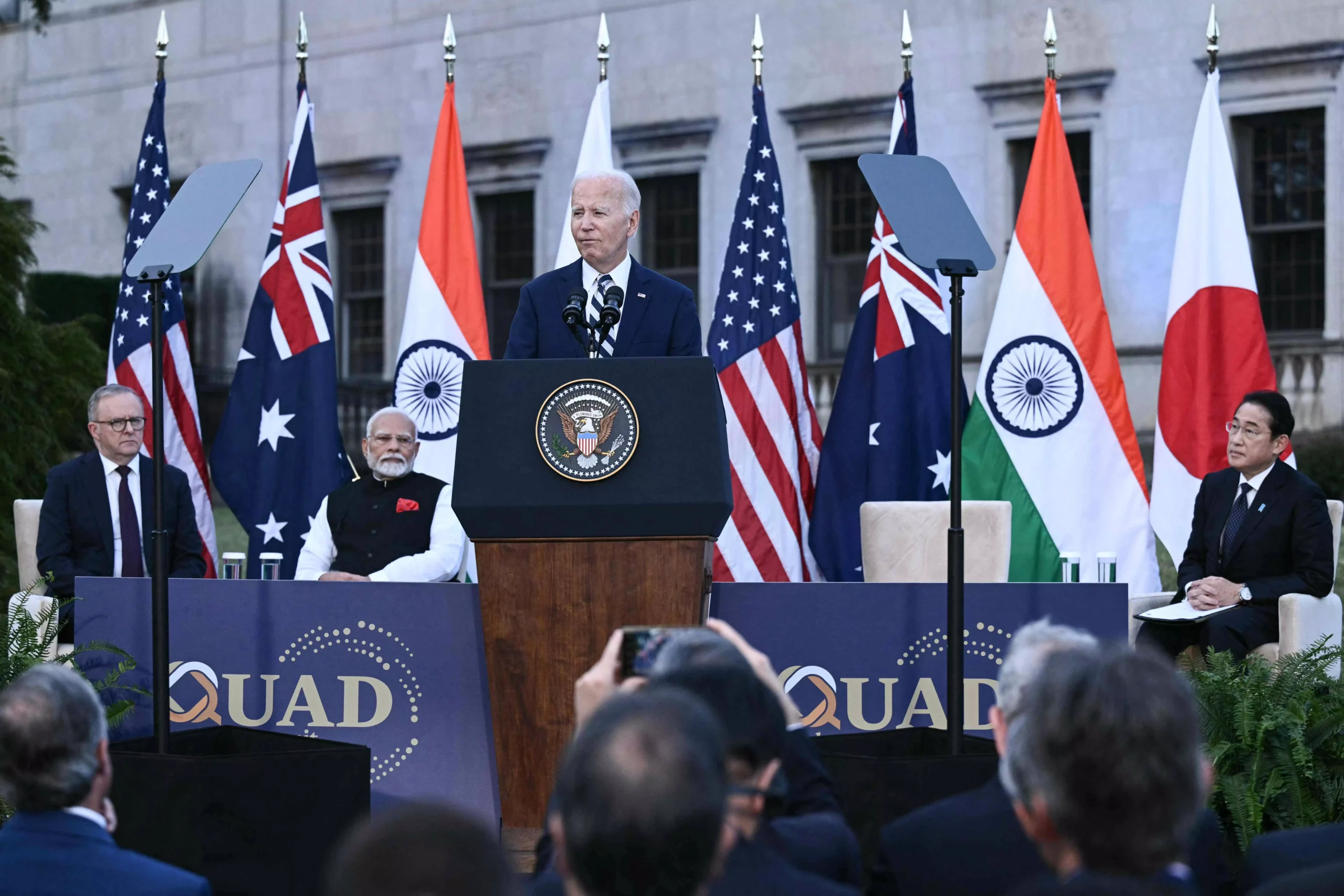
President Joe Biden of the United States hosted a farewell Quad summit in his hometown of Wilmington, Delaware, on September 21. Japanese Prime Minister Fumio Kishida, also demitting office soon, set the trend by hosting the last summit in his hometown of Hiroshima. Will we see the next summit, which India will host in 2025, in Ahmedabad?
The joint statement, called the Wilmington Declaration, recapitulates progress on past decisions and notes fresh appraisal of regional and global issues. However, the focus remains on the Indo-Pacific. The declaration recalls it was Mr Biden who elevated the Quad meetings to the “leader-level format”, four years ago. It calls the gathering as “four leading maritime democracies”, today “more strategically aligned than ever”.
Core elements like human rights, the rule of law, democratic values, sovereignty and territorial integrity were spelt out. The role of regional fora like Asean, the Pacific Islands Forum and the Indian Ocean Rim Association was underscored.
Following introductory statements, multiple themes are tabulated and examined. These are: health security, including the Quad Cancer Moonshot, humanitarian assistance and disaster relief, quality infrastructure, use of artificial intelligence in the next generation of agricultural development and sharing of biodata regarding non-humans amongst members. Climate change and clean energy also got attention. Two additional areas listed are cyber and space.
Although China is not named in the joint statement, most of the themes relate to the danger presented by China’s rise and aggressive challenge to the global order. The Quad sensibly concluded some years ago that to restrain China, military alliances alone are not the answer. In fact, India resisted the group assuming a military dimension. The Quad consensus is that to rival China’s expanding influence in the Indo-Pacific region, the four-nation group must put on the table alternative models for the development of the islands and other nations in the Indo-Pacific. That is why the focus is on providing assistance in healthcare, developing infrastructure, etc, as a counter to China’s Belt and Road Initiative (BRI). The healthcare initiative builds on great work done by the group during the Covid-19 pandemic to help dispense vaccines.
The new danger from Clade 1 mpox is mentioned. The Quad Cancer Moonshot aims to make available both preventive measures and treatment of cervical cancer in the region. India is providing $10 million to the WHO’s Global Initiative in Digital Health.
India, having done great work in establishing Digital Public Infrastructure, has the model handy for the less developed nations of the Global South. The Quad strategy is multi-fold and goes beyond it. One, the aim is to constrain Chinese coercion vis a vis its maritime neighbours. Hence the repetitive calls to enforce international law and defend the UN Charter. Two, effort is required to retain the technological edge over China by working together to develop critical and emerging technologies.
It was recognised that to develop sustainable infrastructure, it is important to impart training. That is why 1,300 Quality Infrastructure Fellowships have already been awarded under the Quad’s leadership. Linked to this theme is a decision to ensure Cable Connectivity Resilience and the Quad Ports of the Future Partnership.
India will be hosting a meeting to take this concept forward.
A good part of the joint statement is devoted to indirectly pointing the finger at China, as well as the Democratic People’s Republic of Korea (North Korea). Hence the need to abide by the UN Convention on the Laws of the Sea (UNCLOS) is forcefully stated. It is not specifically mentioned that China has even been intruding into Japan’s maritime zone and airspace, including recently by sending its aircraft-carrier there. This aggressiveness is even worse in the South China Sea, regarding Taiwan and the Philippines.
The Quad discussed the conflicts in Ukraine and Gaza, with spillover to Yemen, where the Houthi rebels are disrupting traffic through the Red Sea, and Lebanon. In the latter, a suspected Israeli intelligence operation has killed and injured thousands of Hezbollah members, associates and even family members. The joint statement’s observation that the release of hostages would bring a sustainable ceasefire sounds unrealistic as the Israelis are unwilling to accept a permanent ceasefire till they have decapitated the Hamas leadership. In fact, Russian President Vladimir Putin and Israeli Prime Minister Benjamin Netanyahu seem happy to await the US presidential election outcome, hoping that Donald Trump wins, providing them both more leeway.
The Modi-Biden bilateral meeting appeared more about conveying Indian gratitude for the host’s role in advancing the relationship and reaffirming the existing multi-dimensional engagement than introducing any new ideas. The background briefing claimed “unprecedented levels of trust and collaboration”. Defence cooperation was correctly described as a “pillar”. The India-US collaboration in semiconductor fabrication was presented as an example of effective technology-sharing. The Initiative on Critical and Emerging Technologies (iCET) is a path for the two nations, as indeed the Quad as a whole, to ensure that leadership is retained in cutting-edge technologies in coming years. The real battle with China is in these areas.
That is why the United States was blocking China’s easy access to high technology in recent years.
Ironically, as the Quad leaders met, the US is busy electing its next President, who may well be a disruptive element like Donald Trump. In a public speech he claimed that “Modi” was coming to see him. In the same breath he denounced India as a tariff exploiter. This creates a quandary as if Prime Minister Modi meets Mr Trump, perhaps in New York, without meeting Kamala Harris, it would be controversial, on the eve of the presidential election. If he does not, Mr Trump is known to nurse old snubs.
Similarly, the media enquired if the American side had raised the case of “Khalistani” leader Gurpatwant Singh Pannun. The subject was revived when a Sikh delegation was received at the White House and reassured that all US citizens would be protected against any attack from abroad. The Indian side refused to comment, but the issue continues to linger.
Finally, Mr Modi’s Wilmington visit had two purposes. One, to thank Mr Biden for his support for closer engagement with India. Two, to keep the Quad’s momentum going, hoping the American people elect a President committed to protecting the global order. He succeeded in his limited purpose. The Indian diaspora event was a morale booster after the Lok Sabha election setback. Mr Modi returns home to a full programme of electioneering in crucial state Assembly elections, in which his foreign sojourn is unlikely to figure.
